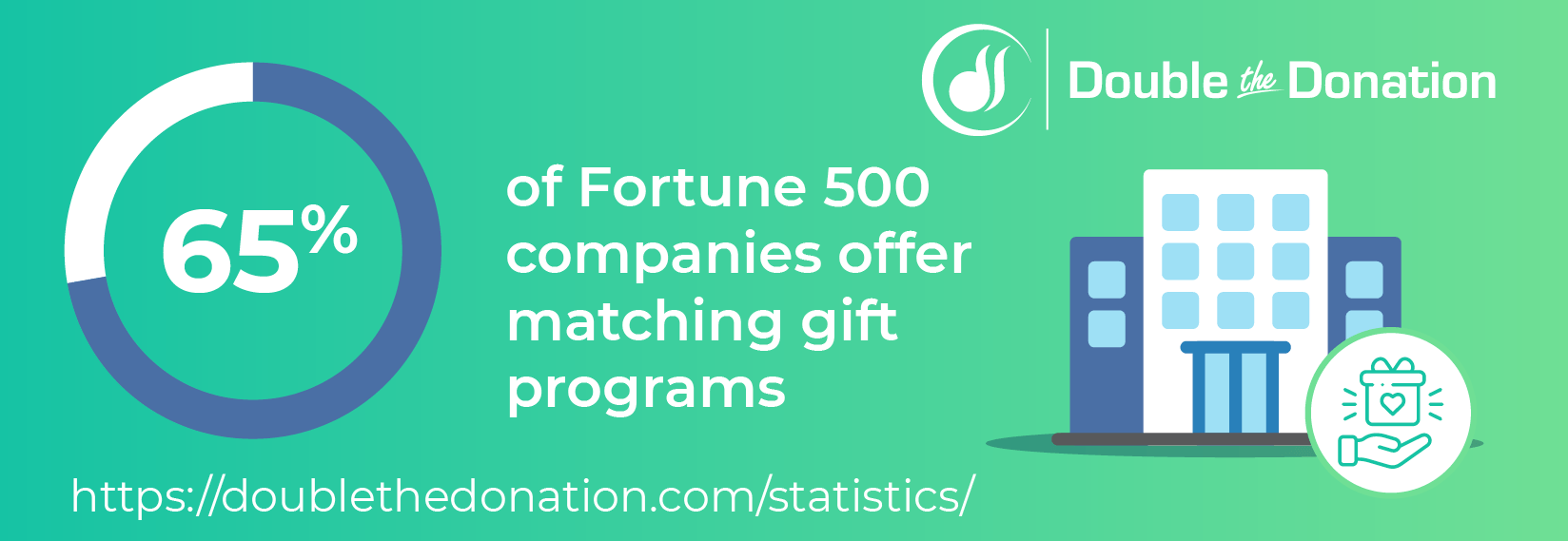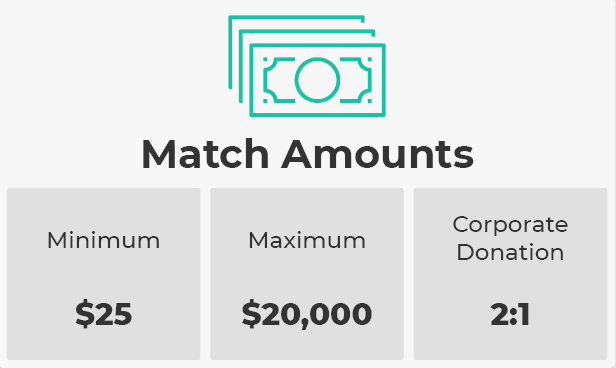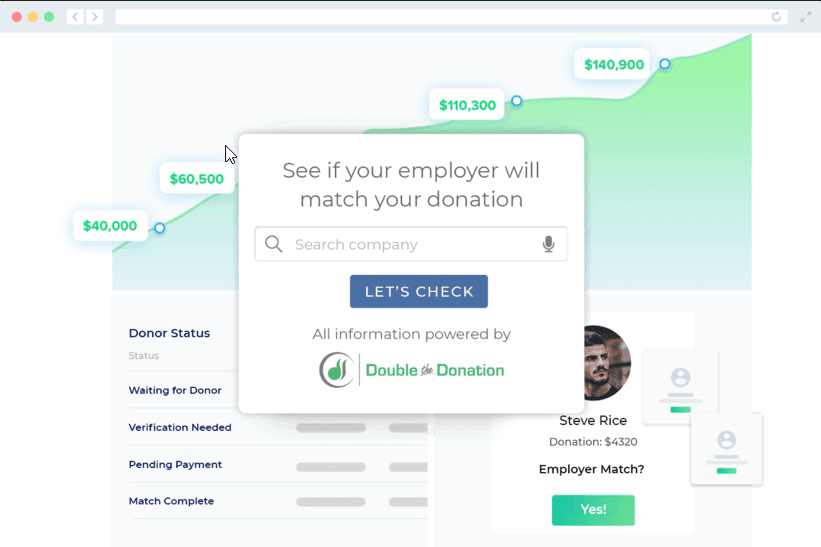
Your matching gift opportunities will melt away… unless you seize them!
You drop your quarters into the slot, tap a couple of buttons, and the machine gives you two candy bars for the price of one. Hallelujah! You’re rich!
The concept of matching gifts works just like that vending machine.
You get twice the money at no additional cost to your donors.
Think of it this way: If someone offered to give your organization free contributions each time someone donated, would you say yes? Of course!
But where is all the free extra money coming from?
The extra “free” money comes from corporations!
Over the past several years, social responsibility has become a phenomenon that’s taken over the for-profit and nonprofit sectors alike. Corporations have quickly become aware of their responsibility to do good in their communities. Each day, more companies are building their initiatives to include new programs to support their employees’ philanthropic efforts. Among these programs are matching gifts that empower donors to double, triple, or sometimes quadruple their gifts to eligible nonprofits.
Here’s what’s new: the digital revolution has made it incredibly easy to determine eligibility and submit match requests.
Here’s what’s sad: a mere 7% of donors at companies with matching gift programs actually submit a request. That equates to more than $4-7 billion in unclaimed revenue every single year, according to recent matching gift studies.

With more than 18 million individuals eligible for matching gifts, there’s a good chance you have some untapped revenue living in your donor database. You just need to find those opportunities, reach out to eligible individuals, and have them send the request to their employers. Luckily, you’ve come to the right place to learn all about matching donations and how they can launch your work forward.
To help you capitalize on corporate philanthropy, we’ll review the following:
- What is a matching gift?
- What eligibility requirements do companies put in place?
- Why do companies offer matching gifts?
- Who offers matching gifts?
- How can you make the most of matching gifts?
With a little extra effort from your team, you can secure a ton more revenue that will do a whole lot of good for your cause. Pursuing this fundraising avenue might be a bit tricky at first, but with time, it’ll become second nature for your team. Ready to secure more matching gift revenue? Let’s dive in.
What is a Matching Gift?
360MatchPro’s playbook on corporate giving defines matching gifts as a “ program wherein a company will match donations made by their employees to a nonprofit organization.” Most companies match at a 1:1 ratio, but some match at a 2:1 or even 3:1 ratio!
Here’s the kicker: corporations won’t just automatically send your nonprofit the money. There’s an easy process your team will need to follow. Here’s how it works with matching gift software:

- Someone donates to your nonprofit.
- The individual checks their eligibility for a company match by searching their employer’s name in a company search tool.
- The donor submits a match request to their employer.
- The company reviews the request and confirms the donation with your nonprofit.
- The company sends a check to your organization.
It’s as simple as that! Consider Kiki, who is Hershey’s official chocolate taster.
Kiki donates $2,000 to the college where she had the best four years of her life. Since she’s an employee of The Hershey Company, the business will match her donation to higher education institutions at a dollar-for-dollar rate. This means they’ll write an additional $2,000 check to the same institution, thus doubling Kiki’s donation.
$2,000 is not mere pocket change. That’s the kind of financial impact that can open opportunities for your nonprofit, especially if you can secure multiple matched major donations.
What Eligibility Requirements Do Companies Put in Place?
While these programs are great ways to give back to worthwhile causes, businesses set requirements regarding which types of donations and organizations are eligible. Companies do this to make sure the nonprofits they’re giving to are credible and align with their values while also not breaking the bank.
Requirements vary by company, and most break it down into these categories:
- Type of organization. Most businesses set general requirements that the nonprofit has to be a registered 501(c)(3) organization, but some get more specific and won’t match donations to specific types of organizations. We’ll look at these more in-depth in the next section.
- Minimum donation amount. This is the lowest amount a donor has to give in order to be eligible for a match from their employer.
- Maximum donation amount. This is the largest amount an employer will give.
- Employee status. This is the type of employee that qualifies for a match. These are typically broken down into a few groups: full-time, part-time, and retired employees. Their spouses are occasionally eligible too.
Knowing what qualifies and disqualifies different donations across companies is important for your team to secure as many matches as possible. As you become well-versed in matching gifts, you’ll start to recognize the companies and amounts you typically receive and start pursuing these opportunities more proactively.
What Nonprofits Are Eligible for Matching Gifts?
As we mentioned, companies often place stipulations regarding which organizations are eligible to receive a match. However, a majority of companies will match donations to these types of organizations:
- Educational institutions – Colleges, universities, K-12 schools, educational foundations
- Arts and cultural organizations – Aquariums, libraries, museums, etc.
- Community-based social services – Homeless shelters, animal shelters, low-income assistance, etc.
- Environmental organizations – Conservation efforts, wildlife preservation, recycling, etc.
- Healthcare organizations – Hospitals, substance abuse programs, medical research, etc.
Other companies might restrict their nonprofit eligibility to nonprofits falling into one or multiple of the above categories. A few common restrictions include political organizations, sports teams, and religious organizations that lack a focus on community outreach.
Why Do Companies Offer Matching Gifts?
65% of fortune 500 companies offer matching gift programs, and a ton of smaller businesses are following suit and offering the opportunity, too. This begs the question: why?

While many companies do care about giving back to their communities, they also receive secondary benefits from offering these programs. For instance, corporate social responsibility initiatives carry other advantages like:
- Positive brand reputations. Think about TOMS Shoes. The TOMS brand is synonymous with their one-to-one shoe program that donated a pair of shoes for each pair purchased. Consumers loved the idea of performing social good through a routine shoe purchase, and the program helped millions of shoe-needy people around the world. Sure, the company truly believed in the social good from offering the program, but the one-for-one shoe program was an effective branding strategy as well.
- A boost in employee morale. When an employee submits a matching gift request, they’re asking their employer to support the organizations and causes they care about. By offering matching gifts, companies agree to support their employees’ passions and thus build employee loyalty and satisfaction.
Giving back to worthwhile causes is certainly on corporations’ agendas; these bonus benefits just sweeten the deal. Thanks to their generosity, they’ll strengthen their companies’ brands while also supporting nonprofit work.
Who Offers Matching Gifts?
In 1954, General Electric started the first corporate matching gift program, and since then, companies of all kinds have embraced corporate philanthropy.
We’ve already mentioned that 65% of Fortune 500 companies offer matching gift programs, but corporate giving isn’t just for the big boys. All sorts of companies large and small, North America-based and international, operate charitable giving programs through which they match employee donations to eligible nonprofits. A company’s size, industry, or location doesn’t disqualify it from corporate giving.
Let’s take a look at a few examples, including minimum match amounts, maximum match amounts, and ratios.

General Electric
Let’s kick things off with the company that started it all! Through its matching gift program, General Electric empowers full-time and part-time employees to request matches to all sorts of organizations.
They match at a 1:1 ratio for donations between $25 to $5,000. They also have a generous deadline for requesting a matching gift. Matches must be requested by April 15th of the year following the initial donation. The program isn’t limited to just U.S.-based nonprofits either; many UK-based organizations can get in on the action, too. Last year alone, they donated $16.8 million in matching gifts.
Microsoft’s Matching Gift Program
To date, Microsoft employees have donated more than $1 billion since 1983. This amount continues to rise with $221 million donated by Microsoft employees last year. Microsoft strives to maximize its corporate giving in October, when the company hosts over 300 activities, such as 5Ks and auctions, to raise funds for nonprofits. However, they offer their matching gift program year-round.
Microsoft matches donations between $1 and $15,000 at a 1:1 ratio. Full-time employees, spouses, board members, and part-time employees are eligible to submit requests. Most nonprofits are eligible. As part of their commitment to empowering nonprofits worldwide, they also donate and discount the Microsoft Cloud for more than 165,000 organizations, which showcases their passion for supporting charitable causes.
Verizon’s Matching Gift Program
Under the Verizon Matching Incentive Program, the Verizon Foundation will match full-time and part-time employees’ donations to a wide range of nonprofit organizations. For every dollar an employee donates, the Verizon Foundation matches the gift at a 1:1 ratio for up to $1,000 to most nonprofits each year. If an employee donates to a college or university the matching gift limit is upped to $5,000 per employee per year to higher education institutions.
The program is extended to retired employees. However, the company focuses strictly on scholarships and curriculum development with this extension, so they’ll only match retirees’ donations to higher education institutions.
They also offer another type of matching gift through their Team Champions program. When teams of 10 or more Verizon employees collectively raise funds for a nonprofit or school, the company will match the funds raised up to $10,000 per team and event. As a direct result of this generosity, Verizon contributed an additional $8.5 million in matching gifts to schools and nonprofits in 2019.
Soros Fund Management
Soros Fund Management ranks as having one of the most generous corporate giving programs out there. With an admirable 2:1 match ratio, employees can make a notable impact on any size donation from $25 to $100,000 per year. In other words, if they donated the full $100,000, the company would donate an additional $200,000, totaling to $300,000 for the cause.
With this type of generosity comes a few stipulations. For instance, the program is limited to full-time employees. That way, they can continue funding the full amount of these requests.
How Can You Make the Most of Matching Gifts?
Just knowing about the value of matching gifts isn’t enough to capture funds. Your team needs to take a proactive approach if you want to maximize your matching gift funds, grow donor loyalty, and make a notable impact on your cause. Here are a few ways you can spread awareness and locate corporate giving opportunities.
Educate your donors when marketing the opportunity.
78% of match-eligible donors have no idea whether their company offers a matching gift program. You can’t expect your donors to submit a request if they’re not quite sure how the process works, or even that the opportunity is available. Letting them know about matching gifts makes them much more likely to look into their eligibility.

Think about it: if you were a donor and were told exactly how you could multiply your impact on a cause without reaching back into your wallet, wouldn’t you jump at the opportunity?
If you want donors to help you secure matching gifts, it’s your job to promote them to your supporters. For instance, you’ll want to outline the process using these strategies:
- Incorporate matching gifts into email newsletters
- Promote matching gifts and educational content on social media
- Feature a dedicated matching gifts page on your site
Then, invite donors to ask your team how they can boost their contributions. Starting the conversation and improving visibility is a major leap in the right direction to securing more matching gifts.
Include a matching gift search tool on your site.
Determining eligibility takes a ton of research, but a matching gift database like Double the Donation can take the guesswork out of the equation. A database collects information about different companies’ matching gift programs and contains specific details regarding the eligibility requirements we discussed earlier.

All your donors have to do is search their employers’ names, and they’ll be instantly met with available matching gift information, including relevant requirements and forms.
To make this search as convenient as possible, here are a few locations on your nonprofit’s website where you’ll want to include this tool:
- Your donation page. If a donor winds up on your donation page, chances are, they’re going to donate. Embed your matching gift search tool on your donation page and your confirmation page to give them multiple opportunities to research their employer.
- Your ‘Ways to Give’ page. You likely already have this page on your site, informing supporters about various ways to support your work. Feature a section on matching gifts that informs them about what they are and provides them with the search tool.
- A dedicated matching gifts page. Not only can this page educate donors on the power of matching gifts, but it can also invite them to research their eligibility when you embed an employer search tool. Check out ASPCA’s matching gifts page for a real-life example of this strategy in action.

Making this information immediately available to your donors eliminates the need for them to go out of their way to determine if they’re eligible. Who knows? They may even increase their donation when they find out their employer will double their impact.
Corporate philanthropy and matching gifts are major buzzwords in the industry, and now you have a solid understanding of why. They’re fantastic ways to multiply the donations you’re already receiving and boost donor loyalty.
It would be great if you could stop by the money pump and simply fill your piggy bank with cash. Unfortunately, the world is not so ideal, and your nonprofit needs to fight for every dollar it can get. Matching gifts are an easy way to increase fundraising, so start promoting corporate giving today and rejoice when you receive two donations instead of one.
The preceding is a guest post by Adam Wenger, President of Double the Donation, the leading provider of matching gift tools and service to nonprofits. Connect with Adam on LinkedIn or Twitter.,
Photo courtesy of Freedigitalpotos.net






